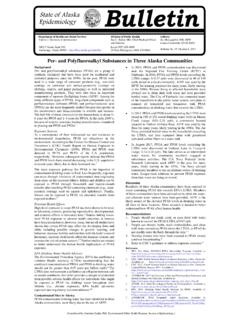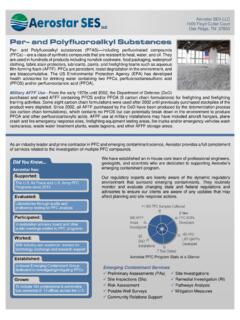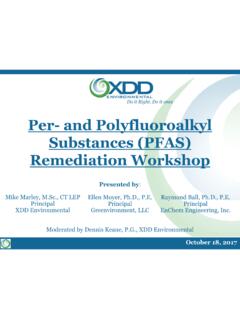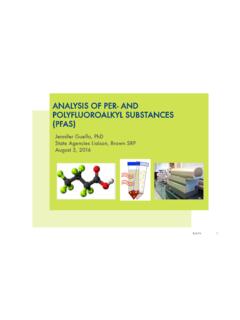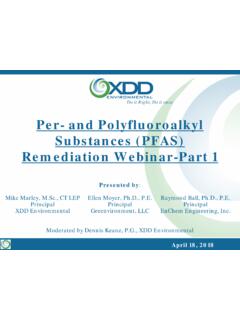Transcription of Dossier Per- and polyfluoroalkyl substances (PFASs)
1 DOI: 1 Dossier Per- and polyfluoroalkyl substances ( pfass ) July 2016 Birgit Geueke 1 IntroductionPerfluoroalkyl and polyfluoroalkyl substances ( pfass ) are used in various consumer and industrial products, including food contact materials (FCMs) (Figure 1). Thousands of different pfass have been synthesized in the past decades [1]. Their common properties include high water and oil repellency as well as thermal and chemical stability. PFAS are fluorinated aliphatic substances in which the hydrogen substituents of at least one terminal carbon atom are completely replaced by fluorine atoms, all PFAS contain the moiety CnF2n-1- [2]. substances where fluorine is substituted for all hydrogen atoms (except those belonging to functional groups) are designated as perfluoroalkyl substances .
2 In contrast, polyfluoroalkyl substances contain not only fluorinated, but also (partially) hydrogenated carbon atoms [2-4]. Chemical bonds between carbon and fluorine are the strongest single bonds in organic chemistry [5]. Consequently, many perfluoroalkyl substances are highly persistent under abiotic and biotic conditions. polyfluoroalkyl substances may be converted to a certain extent, but any perfluorinated parts of such molecules persist [2]. The extensive application and the high persistency of many pfass contribute to their ubiquitous presence in biota and environmental samples. In wildlife and humans, high absorption and low elimination rates further increases the body burden of some pfass . Although a high diversity of pfass has been synthesized in the last decades, the level of available information varies strongly for the different pfass : whereas few compounds have been thoroughly investigated, others are hardly characterized.
3 Fluorinated polymers form a second group of fluorinated organic molecules that are widely used in FCMs, as coating on cookware to provide non-stick properties. 2 Definition and nomenclature pfass are aliphatic substances containing, as a minimum requirement, one terminal carbon atom on which all hydrogen substituents have been replaced by fluorine atoms. As detailed above, pfass can be divided into poly- and perfluoroalky substances . Many pfass are used as surfactants or in the production of fluorinated polymers. Fluorosurfactants form a heterogeneous group of pfass that consist of a fluorinated carbon chain and a highly hydrophilic functional group or moiety and have a molecular weight below 1000 Da [4]. Many industrially used fluorosurfactants are mixtures of compounds with different chain lengths and of undefined purity [6, 7].
4 Fluorinated polymers containing a perfluoroalkyl moiety CnF2n-1- belong to the pfass . However, the definition of fluorinated polymers includes also all other polymers containing fluorine in the backbone or side chain of at least one monomer. Fluoropolymers form a subgroup of fluorinated polymers with a backbone solely composed of carbon atoms and fluorine directly attached to it. Further details about the terminology for pfass was provided by Buck and colleagues with the aim to harmonize the chemical nomenclature for these substances and to avoid inconsistencies [2]. Examples of pfass Perfluoroalkane sulfonic acids (PFSA) PFSAs belong to the group of perfluoroalkyl acids (PFAAs) and typically have linear perfluoroalkyl chains and a sulfonic acid or sulfonate group as functional group (1). PFSAs with 6 or more fluorinated C-atoms belong to the long-chain pfass [2].
5 PFSAs are precursors of perfluoroalkane sulfonamides (2) that can carry a wide range of different side chains ( R, R = alkyl, alcohol, (meth)acrylates, phosphate). The best investigated PFSAs are perfluorooctane sulfonic acid (PFOS, 3, CAS 1763-23-1) and perfluorooctane sulfonates (CAS 45298-90-6), which have been used as surfactant in many different applications until the global voluntary phase-out by the main manufacturer 3M in 2002. Examples of PFSA derivatives that have been used in FCMs are perfluorooctane sulfonamidoethanol-based phosphate esters (SAmPAPs), and side-chain fluorinated polymers [2, 8, 9]. Figure 1. Examples of FCMs containing per- and polyfluoroalkyl substances ( pfass ) and fluorinated polymers. 2 Perfluoroalkyl carboxylic acids (PFCA) PFCAs, another important group of PFAAs, have the general structure CF3(CF2)nCOOH (4).
6 Perfluorooctanoic acid (PFOA, 5, CAS 335-67-1) is the most prominent example of PFCAs. PFOA is available as free acid, various salts, and in functional derivatives. The ammonium salt of PFOA (APFO, CAS 3825-26-1) has been widely used as emulsion polymerization aid in the production of certain fluoropolymers. PFOA is also an unintended by-product in the production of fluorotelomers (see and ). PFCAs with 7 or more fluorinated C-atoms belong to the long-chain pfass [2]. Table 1. Examples of pfass belonging to the perfluoroalkane sulfonic acids (PFSAs), perfluorocarboxylic acids (PFCAs), and fluorotelomer alcohols (FTOHs). n = number of fluorinated carbon atoms. substance n CAS # PFSAs (1) Perfluorobutane sulfonic acid (PFBS) 4 375-73-5 Perfluoropentane sulfonic acid (PFPeS) 5 2706-91-4 Perfluorohexane sulfonic acid (PFHxS) 6 355-46-4 Perfluoroheptane sulfonic acid (PFHpS) 7 375-92-8 Perfluorooctane sulfonic acid (PFOS) (3) 8 1763-23-1 PFCAs (4) Perfluorobutanoic acid (PFBA) 3 375-22-4 Perfluoropentanoic acid (PFPeA) 4 307-24-4 Perfluorohexanoic acid (PFHxA) 5 357-24-4 Perfluoroheptanoic acid (PFHpA) 6 375-85-9 Perfluorooctanoic acid (PFOA) (5) 7 335-67-1 Perfluorononanoic acid (PFNA) 8 375-95-1 FTOHs (7) 6:2 Fluorotelomer alcohol (6:2 FTOH) 6 647-42-7 8:2 Fluorotelomer alcohol (8:2 FTOH) 8 678-39-7 Fluorotelomer-based substances Fluorotelomers are molecules with straight, even-numbered fluoro-carbon chains of limited lengths (n greater than 1 and often less than 10) (6).
7 Perfluoroalkyl iodides ( F(CF2CF2)nI, Figure 3) are used to synthesize a variety of derivatives, such as fluorotelomer alcohols (FTOHs, 7), fluorotelomer olefins (FTOs, 8), polyfluoroalkyl phosphate monoesters (monoPAPs, 9), and polyfluoroalkyl phosphate diesters (diPAPs, 10). Fluorotelomer acrylates and methacrylates are major raw materials for fluorotelomer-based polymers. Examples of fluorinated polymers Polytetrafluoroethylene (PTFE, 11, CAS 9002-84-0) is a linear high-molecular weight polymer composed of tetrafluoroethylene units. PTFE consists only of fluorine and carbon atoms. It is sold under the trade name Teflon and Dyneon PTFE. Perfluoroalkoxy polymers (12) are related to PTFE, but have side chains connected by ether bonds. Fluorinated ethylenepropylene (FEP, 13) is a copolymer of tetrafluoroethylene and hexafluoropropylene monomers. Perfluoropolyethers (PFPEs, 14) are polymerized from hexafluoropropylene oxide and generally composed of 10-60 monomers.
8 They are sold under the trade name Kryotox . 3 Physical and chemical properties The substitution of hydrogen by fluorine atoms in aliphatic molecules leads to a similar variety of substances as can be found in hydrocarbon chemistry [3]. Long perfluorinated carbon chains form a helical structure, in which the carbon skeleton is completely covered by fluorine atoms. This cover shields the molecule from most chemical attacks resulting in highly stable molecules. Additionally, the standard C-F bond is the strongest single bond known in organic chemistry and also the C-C bonds between two fluorinated carbons are stronger than between two hydrogenated carbons [5]. Thus, pfass have high thermal stability, chemical resistance and general persistence [3, 10]. The fluorinated side chains of pfass have a low surface energy leading to strong water and oil repellency of fluorinated chemicals with sufficient chain lengths [5, 11].
9 Furthermore, low intermolecular interactions between fluorinated side chains make pfass relatively volatile, although they have a much higher molecular weight than their hydrocarbon analogues [5]. More details on the physicochemical properties of pfass were recently summarized by Krafft and Riess [5]. SFFFOOOHFSOOFFFFFFFFFFFFFFFFOHSFFFOONRR' nn123R, R' = H sulfonamideR, R' = H N-substituted sulfonamidesFFFOOHOFFFFFFFFFFFFFFFOHn45 RFFFFFn6 FFFFFOH7 FFFFOFPOHOOH9nFFFFOFPOOOHFFFFF10nnnFFFFF 8nFFFFFFFOCF3nmFFFFnFFFFCF3 FFFnm111213CF3 FFFOn143 4 Chemical synthesis Electrochemical fluorination A major production route of long-chain PFSAs and PFCAs has been electrochemical fluorination (ECF) [12]. Linear alkane sulfonyl fluorides (CnH2n+1SO2F) and linear alkane acyl fluorides (CnH2n+1 COF) are electrochemically fluorinated in hydrofluoric acid (HF) to perfluorinated sulfonyl fluorides (CnF2n+1SO2F) and acyl fluorides (CnF2n+1 COF), respectively (Figure 2A and B) [5, 13].
10 Due to the harsh and non-selective reaction conditions, the final products can be obtained at a low yield and accompanied by a mixture of linear chain, branched chain, and cyclic perfluorinated molecules. CnF2n+1SO2F is further converted into PFSA, the corresponding sulfonate salts, sulfonamides and sulfonamidoethanols (Figure 2A). This synthesis route has been mainly used for the production of PFOS from C8F17SO2F (perfluorooctane sulfonyl fluoride, POSF). CnF2n+1 COF species are the precursor molecules of PFCAs and their corresponding salts (Figure 2B). (CnF2n+1SO3H), (B) synthesis of PFCAs (CnF2n+1CO2H). Telomerization An alternative, more specific production route of pfass is the telomerization process [2]. In a first step, tetrafluoroethylene (TFE, CAS 116-14-3) reacts with a perfluoroalkyl iodide yielding a distribution of linear perfluoroalkyl iodide telomers with a chain length that is divisible by 2 (Figure 3).
